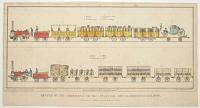
Sketch of the Carriages on the Liverpool and Manchester Railway.
Drawn by Henry Austen, March, 1832. Printed by George Smith.
Published by Thomas Taylor, Castle Street. [n.d. 1832.]
Hand coloured wood engraving. Sheet 155 x 300mm (6 x 11¾"). Creasing in the top left corner.
Two strips showing two trains of carriages, pulled by the steam locomotives 'Planet' (above) and 'Venus'; for passengers as well as wagons for livestock and goods. The line between Liverpool and Manchester was 31 miles (50 km) long and was built under the supervision of the Liverpool & Manchester Railway’s (LMR) chief engineer George Stephenson (1781-1848). Opened on 15 September 1830, it was the world’s first intercity railway. With numbered key to each car.
[Ref: 56999] £360.00
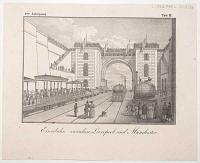
Eisenbahn zwischen Liverpool and Manchester. 6ter Jahrgang. Tab II.
[n.d., c.1830].
Lithograph, sheet 190 x 240mm (7½ x 9½").
German print of the opening of the Liverpool and Manchester Railway 15th September 1830. The Duke of Wellington's train and other locomotives being readied for departure from Liverpool and people atop the Moorish Arch at Edge Hill wave and cheer.
[Ref: 57066] £140.00
(£168.00 incl.VAT)

Travelling on the Liverpool and Manchester Railway. A Train of the First Class of Carriages, with the Mail.
Drawn by J. Shaw, Liverpool. Aquat.a by S.G. Hughes.
[n.d., 1860] But later.
Coloured aquatint. Sheet 295 x 630mm (11½ x 24¾").
A profiles of the 'Jupiter' locomotive and its carriages, built by Robert Stephenson and Company. Based on the print published by Ackermann in 1833, copying the artist and engraver's inscriptions.
[Ref: 58741] £220.00
(£264.00 incl.VAT)

Near Liverpool, looking towards Manchester.
T. T. Bury. H. Pyall, sculp.t.
London, Pub.d. by R. Ackermann, 96 Strand, 1831.
Fine hand-coloured aquatint. Platemark: 255 x 290mm (10 x 11¼"). Some staining along edges.
A view depicting a new railway line, with a train approaching from under a bridge. Several bridges are seen in the distance, as figures walk along the bank, one walking along the tracks. From 'Coloured views of the Liverpool and Manchester railway, with plates of the Coaches, Machines. &c. from drawings made on the spot by T. T. Bury. with descriptive particulars, serving as a guide to Travellers on the Railway. London.' published by Ackermann in 1831. Abbey, Life: 400.
[Ref: 40016] £160.00
(£192.00 incl.VAT)

Entrance to the Liverpool Station.
Printed by C. Hullmandel. [n.d., c.1830.]
Rare Lithograph, sheet 175 x 115mm. 7 x 4½". Sheet trimmed; corner tips clipped.
The first railway station at Liverpool at Crown Street, and tunnels, on the Liverpool & Manchester Railway (LMR), the world's first inter-city railway. By 1836 Crown Street had stopped being a passenger station and had been relegated to a goods and engineering maintenance depot. The LMR opened on 15 September 1830, and linked the textiles centre of Manchester, Lancashire with Liverpool, the most important port in the north of England.
[Ref: 18295] £130.00
(£156.00 incl.VAT)

Liverpool Station and Entrance to the Tunnels. Liverpool and Manchester Rail Road.
[Lithog.d by W. Crane., c.1831.]
Lithograph, rare. 152 x 108mm (6 x 4¼"). Trimmed.
A view of Crown Street station and tunnels on the Liverpool & Manchester Railway (LMR), the world's first inter-city railway. The first railway station at Liverpool was at Crown Street, which by 1836 had stopped being a passenger station and had been relegated to a goods and engineering maintenance depot. The LMR opened on 15 September 1830, and linked the textiles centre of Manchester, Lancashire with Liverpool, the most important port in the north of England.
[Ref: 28940] £140.00
(£168.00 incl.VAT)
![[Ljubljana-Trieste Railway] Zur Erinnerung Eröffnung der Staats-Eilenbahn von Laibach bis Triest](img-thumbnail/jpegs/33487.jpg)
[Ljubljana-Trieste Railway] Zur Erinnerung Eröffnung der Staats-Eilenbahn von Laibach bis Triest unter den Allerhöchsten Auspicien Seiner k.k. apost. Majestät des Kaiser Franz Josef I. am 27. Juli 1857.
[Vienna: Reiffenstein & Rosch, n.d., c.1857.]
Portfolio, original blind decorated cloth, lettered in gilt, ties; pp. 10, loose leaves; lithographed title, folding chromolithographed geological profile, folding lithographic map, 14 numbered chromolithographic views, as called for. Scarce.
A portfolio of views of the new Ljubljana to Triest Railway, drawn and lithographed by Jan Novopacky (1821-1908), Gottfried Seelos et J. Varoni, with a short description and two maps, apparently published to commemorate the railway's opening by Emperor Franz Josef I in 1857. This was the final section of a railway linking Vienna to Trieste, then all part of the Habsburg empire, but now in Slovenia and Italy. The plates illustrate some of the obstacles on the route, including flood plains and mountains, and how they were overcome, with viaducts and tunnels. The new station at Trieste is also depicted.
[Ref: 33487] £1,400.00
view all images for this item

Single Express Locomotive, Midland R.y. Mr. S. W. Johnson, M.I.C.E., Locomotive Engineer Derby. Supplement to the Locomotive Magazine. January 1898.
Reproduced from a Painting by F. Moore.
Alf Cooke Queen's Printer Leeds.
Chromolithograph. Sheet: 270 x 440mm (10½ x 17½''). Marking, creases and damage.
An illustration of a steam train locomotive from the Midland Railway. Plate from 'The Locomotive Magazine Series'. 'F. Moore' was a pseudonym, believed to have been originally for Edwin Thomas Rudd but used by others at least into the 1930s.
[Ref: 48345] £85.00
(£102.00 incl.VAT)
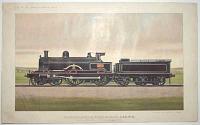
Four-Cylinder Compound Express Locomotive, L. & N.W. Ry. Mr F.W. Webb, M.I.C.E., Chief Mechanical Engineer, Crewe. No 13. The Locomotive Magazine Series.
Reproduced from a Painting by F. Moore [i.e. Edwin Thomas Rudd]. Alf Cooke, Queen's Printer, Leeds.
[n.d., September 1901.]
Chromolithograph. Sheet 270 x 440mm (10½ x 17¼"), A few stains & creases.
An illustration of the locomotive 'King Edward VII', with a tender. From No 69 of 'The Locomotive Magazine Series'. 'F. Moore' was a pseudonym, believed to have been originally for Edwin Thomas Rudd but used by others at least into the 1930s.
[Ref: 57118] £50.00
(£60.00 incl.VAT)
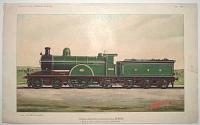
Single Express Locomotive, G.N. Ry. Supplement to The Locomotive Magazine Series.
From a Painting by F. Moore [i.e. Edwin Thomas Rudd]. Alf Cooke, Queen's Printer, Leeds.
[n.d., June 1900.]
Chromolithograph. Sheet 270 x 440mm (10½ x 17¼"), A few stains.
An illustration of a locomotive and tender. From No 54 of 'The Locomotive Magazine Series'. 'F. Moore' was a pseudonym, believed to have been originally for Edwin Thomas Rudd but used by others at least into the 1930s. See Ref: 48345
[Ref: 57121] £50.00
(£60.00 incl.VAT)
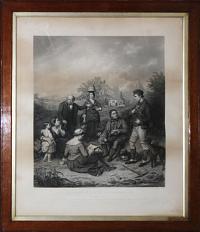
The Birth-Place of the Locomotive. Killingworth Colliery.
Painted by John Lucas. Engraved by F Holl and C Mottram.
London, Published August 30th 1862 by Henry Graves and Co, The Proprietors, Publishers to the Queen _ 6 Pall Mall.
Stipple & engraving. 780 x 650mm, 30¾ x 25½". Contemporary frame. Some burn from backboard. Unexamined out of frame.
A group of villagers outside 'Sundial Cottage', George Stephenson's home at Killingworth Colliery, where he built his first steam locomotive, the 'Blücher', in 1814. A basic locomotive can be seen outside the cottage, and a more advanced model crosses the stone bridge in the far background, representing the North-Eastern Line to Scotland. The group is discussing Stephenson: one woman reads the 'London Journal', containing Stephenson's portrait and a man holds a 'Geordie' lamp, Stephenson's safety-lamp for miners. Derived from a diminutive form of the inventor's name, it is said that the name lead to Tyneside miners also being called Geordies.
[Ref: 24864] £480.00
Unfortunately this item is either sold or reserved. If you are interested in similar items and cannot find what you're looking for on our website, please consider filling in our interests form. If you register, we can also send you items that match your interests when the website is updated.
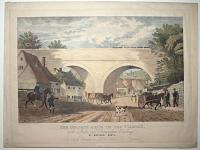
The Oblique Arch in the viaduct on the London & Birmingham Railway at Watford, Herts. Dedicated by permision to G W Buck, Esq.r Engineer.
Drawn & Lithographed by W.m Sharp, Sen.r
[n.d., c.1840.]
Rare & fine coloured lithograph. Sheet 320 x 435mm (12½ x 17"). Slight mount burn.
The Bushy Arches, Watford, on the London to Birmingham Railway soon after the opening in 1838.
[Ref: 53000] £450.00

Railway and Viaduct, Across the Turnpike Road, Watford, _ Herts.
Drawn from Nature & on Stone, by J.C. Oldmeadow.
[n.d., c.1840.]
Coloured lithograph. Sheet 285 x 395mm (11¼ x 15½"). Slight mount burn.
The Bushy Arches, Watford, on the London to Birmingham Railway soon after the opening in 1838.
[Ref: 52999] £360.00

View of the Termination of the London Grand Junction Railway at Skinner Street.
[Standidge and Lemon, Litho.] [n.d., c.1835.]
Rare lithograph. Sheet 265 x 355mm (10½ x 14") Trimmed at bottom, losing printer's inscription.
A hypothetical view of the terminus steps of the planned 'London Grand Junction Railway', intended to link the City of London to Camden Town and the London and Birmingham Railway. To the side are the Saracen's Head Hotel and St Sepulcre's Church. The railway was over-ambitious and did not raise enough money to become viable, despite being approved by Act of Parliament.
[Ref: 52989] £220.00
(£264.00 incl.VAT)

This View of the Entrance to the London Grand Junction Railway, at Skinner Street, as Approved by the Committee of the House of Commons, and agreed with the Corporation of London.
[Standidge and Lemon, Litho.] [n.d., c.1835.]
Rare coloured lithograph. Sheet 350 x 440mm (13¾ x 17¼"). A few tears and loss at edge & bottom left..
A view of the proposed frontage of the planned 'London Grand Junction Railway', intended to link the City of London to Camden Town and the London and Birmingham Railway. Behind is St Sepulcre's Church. The railway was over-ambitious and did not raise enough money to become viable, despite being approved by Act of Parliament.
[Ref: 52993] £330.00
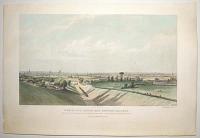
View of the London and Croydon Railway. From the deep cutting made through the hill at New Cross Hill, looking towards the Greenwich Railway.
On stone by E. Duncan. Day & Haghe Lith.rs to the Queen.
Published at 105 Leadenhall Street, 1st June 1838.
Coloured lithograph. Printed area: 490 x 285mm. (19¼ x 11¼"), with large margins.
The London and Croydon Railway was opened in 1839. Extensive earthworks were needed at New Cross, otherwise the gradient of 1 in 100 would have been too steep. This view shows the impact of the newly built railways on the surronding environment; the railway track and deep verges divide the landscape and a steam train can be seen travelling towards London.
[Ref: 53675] £360.00
![[State Visit of Louis Phillippe of France.] Le Roi a la Station de New-Cross.](img-thumbnail/jpegs/56694.jpg)
[State Visit of Louis Phillippe of France.] Le Roi a la Station de New-Cross.
Ed. Pingret pinx.t. A.d Cuvillier & Bayot. Imp. par Lemercier à Paris.
Paris, chez Chaillou [n.d., c.1844].
Fine coloured tinted lithograph on chine collé, on printed backing card. Printed area 320 x 395mm (12½ x 15½").
Louis Phillippe, king of the French, arriving at New Cross Station, Deptford, at the beginning of his state visit to Windsor Castle in 1844. His road carriage sits on a tender. A good image of a c. 1840's train and carriage.
[Ref: 56694] £260.00
(£312.00 incl.VAT)
![[The Watford Tunnel Collapse, 1835.] A Man that is Married.](img-thumbnail/jpegs/55370.jpg)
[The Watford Tunnel Collapse, 1835.] A Man that is Married. Air. _ Love Sick Looby.The Swiss Toy Girl. [WITH OLD INK MSS] This Song Belonged to James Carrick one of the Unfortunate of the Ten who was Buried in the Watford Tunnel and this was Buried with Him from the 16th July 1835 Till the 18th August 1835 and he was the Last Found.
Pitts' Printer, Toy & Marble Warehouse, 6 Great st Andrew street, Seven Dials.
Letterpress broadside song sheet. Sheet 250 x 200mm (9¾ x 8"). Some wear to old folds.
A songsheet with the lyrics to two ballads. According to the ink mss the sheet was buried with its owner in the collapse of the Watford Tunnel while it was being dug for the London & Birmingham Railway. Although the tunnel was mostly solid chalk there were areas made unstable by seams of gravel; a night crew, removing wooden struts to prepare for bricking the walls of a ventilation shaft, were buried 80 feet down under gravel, chalk and timbers. Despite working around the clock, it still took over a month to extricate the bodies. Bodleian Ballads Online Bod12422.
[Ref: 55370] £280.00
(£336.00 incl.VAT)

Bridge over the Irwell, Victoria Station, Manchester.
A.F. Tait, del et lith.
Day & Haghe lith.rs to the Queen [1845]
Lithograph with tintstone, printed area 270 x 360mm (10½ x 14¼").
Bridge near Victoria station in Manchester, named in honour of the monarch at the time it was opened in 1844, queen Victoria. Plate from 'Views on the Manchester & Leeds Railway' (1845), by Arthur Fitzwilliam Tait. The volume depicted notable bridges and stations on the route, which opened in 1839. Abbey 411.5.
[Ref: 43304] £200.00
(£240.00 incl.VAT)

Rastrick Terrace & Viaduct
A.F. Tait, del et lith.
Day & Haghe lith.rs to the Queen [1845]
Lithograph with tintstone, printed area 250 x 365mm (9¾ x 14¼").
Plate from 'Views on the Manchester & Leeds Railway' (1845), by Arthur Fitzwilliam Tait. The volume depicted notable bridges and stations on the route, which opened in 1839. Abbey 411.14
[Ref: 43305] £180.00
(£216.00 incl.VAT)

Rochdale Station.
A.F. Tait, del et lith.
Day & Haghe lith.rs to the Queen [1845]
Lithograph with tintstone, printed area 255 x 345mm (10 x 13½"). Slight stain off image bottom left. Tears to margins one slightly going into image.
The first railway station in the town of Rochdale, Greater Manchester, which served the line from Manchester to Leeds. After the increasing traffic became too great for the station, it was replacded by the larger current depot in 1889. Plate from 'Views on the Manchester & Leeds Railway' (1845), by Arthur Fitzwilliam Tait. The volume depicted notable bridges and stations on the route, which opened in 1839. Abbey 411.17
[Ref: 43309] £190.00
(£228.00 incl.VAT)
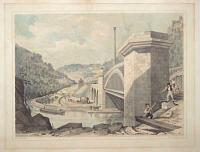
Whiteleys Viaduct, Charleston Curves.
A.F. Tait, del et lith.
Day & Haghe lith.rs to the Queen [1845].
Tinted lithograph with hand colour. Printed area 240 x 325mm (9½ x 12¼"). Faint mount burn.
A view of the viaduct carrying the Manchester & Leeds Railway over the River Calder near Hebden Bridge, with navvies working on the line and a barge on the river below. Plate from 'Views on the Manchester & Leeds Railway' (1845), by Arthur Fitzwilliam Tait. The volume depicted notable bridges and stations on the route, which opened in 1839. Abbey 411.
[Ref: 57351] £200.00
(£240.00 incl.VAT)
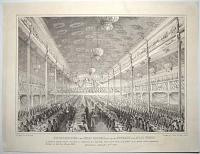
Representation of the Great Banquet given by the Workmen of the Atlas Works to Henry Sharp, Esq.re in honor of attaining his Majority, when 1,000 men sat down to a warm and sumptuous Dinner, in the Free Trade Hall, Manchester, September 10th 1847.
on Stone by W. Physick. Printed by J. Gow, 65 Water Street.
[Manchester, c.1847.]
Rare lithograph. Sheet 285 x 390mm (11¼ x 15¼"). Repaired tear just entering printed area at top, creasing bottom right.
A view of the second of three Free Trade Halls built on St Peter's Fields (site of the Peterloo massacre which took place in August 1819). The Atlas Works, opened in 1828, was the factory of Sharp Brothers and Company. In 1833, in an earlier incarnation (as Sharp, Roberts & Co.) they had built a locomotive, 'Experiment', for the Liverpool and Manchester Railway. They built over 600 locomotives nicknamed 'Sharpies', between 1837-1857. Among the railways supplied were the Grand Junction Railway, London and North Western Railway and the Great Indian Peninsula Railway.
[Ref: 54194] £280.00
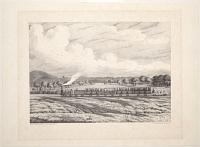
The Midland Railway, At Swillington 1841. Lithograph by & Actor H. Perry.
Lithographed by Henry Perry, May, 1841. J. Graf, Printer to Her Majesty.
1841.
Lithograph. 240 x 305mm (9½ x 12"). In mount. Slight foxing.
Landscape of a train passing through Swillington on the new North Midland Railway, which opened in 1840 connecting Derby to Leeds.
[Ref: 55111] £320.00

Mill Lane Archway and Excavation at Olive Mount See page 51
[published in Chester, 1830.]
Lithograph, 205 x 115mm. 8 x 4½". Uncut.
The Olive Mount Cutting, on the Liverpool & Manchester Railway near Liverpool, was one of the first extensive cuttings on any railway, and one of the most extensive. The sandstone rock blasted out was used to make the Sankey viaduct and other buildings for the LMR. Originally published as one of 'Eight Views illustrating The Liverpool and Manchester Railway, and the Engines and Carriages employed upon it' published in Chester in 1830 and described by Abbey as 'a flimsy booklet of the greatest rarity'. Abbey Life: 404.1
[Ref: 8874] £70.00
(£84.00 incl.VAT)

Gate-Keeper's Lodge, Newark. Nottingham and Lincoln Railway. Dersigned under the direction of F. Stanwick Esq.re C.E. J.A. Davies, Arch.t.
W.L. Walton lith. Printed by Hullmandel & Walton.
[n.d., c.1846.]
Very scarce lithograph. Sheet 295 x 350mm (11½ x 13¾") with large margins.
The Nottingham and Lincoln Railway opened in 1846. J.A. Davies also designed Newark Castle Station.
[Ref: 61495] £190.00
(£228.00 incl.VAT)
![Central Railway Station, Newcastle. (Uniform with a View of the Interior.) [&] Interior of the Central Railway Station, Newcastle. (Uniform with a View of the Exterior.)](img-thumbnail/jpegs/27411.jpg)
Central Railway Station, Newcastle. (Uniform with a View of the Interior.) [&] Interior of the Central Railway Station, Newcastle. (Uniform with a View of the Exterior.)
John Dobson, Esq. Archt.
Published by Andrew Reid, Lithographer, 117, Pilgrim Street, Newcastle.
Pair of lithographs on india paper, scarce; each sheet 280 x 380mm. 11 x 15". Margins slightly soiled and stained; generally good copies with large margins.
The interior view shows a steam locomotive at the station on the Newcastle & Carlisle Railway designed by John Dobson (1787-1865). It was opened on 29 August 1850 by Queen Victoria. Not in Abbey.
[Ref: 27411] £320.00
view all images for this item

Bridge and Excavation at Olive Mount. Liverpool and Manchester Rail Road.
[n.d. c.1832.]
Lithograph on india, rare. 132 x 160mm (5¼ x 6¼"). Trimmed; creasing on india paper.
Built under the supervision of chief engineer George Stephenson (1781-1848), the Liverpool & Manchester Railway (LMR) was the world's first intercity railway. The Olive Mount Cutting, on the LMR route near Liverpool, was one of the first extensive cuttings on any railway, and is still considered one of the most formidable. It is approximately two miles long, and in some parts nearly 80 feet (25 metres) deep. The sandstone rock was blasted out and used to construct the Roby Embankment and the Sankey Viaduct, also on the LMR.
[Ref: 28939] £110.00
(£132.00 incl.VAT)
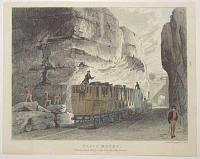
Olive Mount.
Drawn & Engraved by I. Shaw.
[British, c.1831.]
Wood engraving, rare; image 155 x 210mm (6 x 8¼"). Crease top left corner.
Engraving by Isaac Shaw showing a view of a steam locomotive pulling carriages through the Olive Mount cutting during the construction of the railway line between Liverpool and Manchester. The Liverpool & Manchester Railway was the world's first inter-city railway and was built under the supervision of chief engineer George Stephenson. Railways were developed mainly for the transportation of goods, mainly coal, but it was quickly realised that trains were also a good way of carrying passengers.
[Ref: 57065] £140.00
(£168.00 incl.VAT)
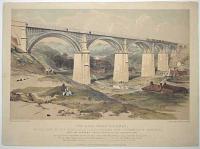
The Ouse Burn Viaduct, in the Line of the Newcastle, North-Shields and Tynemouth Railway, Jonh [sic] and Benjamin Green, Architects and Engineers 1838.
T.M. Richardson Sen.r del & lithog.r. A Ducôtés Lithog.y 70 St Martins Lane London.
London, Published by T. McLean, 26, Haymarket, & F. Loraine, Grey St, Newcastle upon Tyne [n.d., c.1838].
Tinted lithograph with hand colour, on card, as issued. Sheet 345 x 475mm (13½ x 18¾).
A railway viaduct, built 1838 with five laminated timber arches. These were replaced with iron on 1867, when the bridge was widened to four tracks. The Ouseburn Viaduct is now listed Grade II*.
[Ref: 56684] £480.00
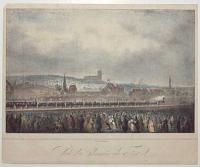
Vue du Chemin de Fer.
Lith. de Daems.
[n.d., c.1840.]
Coloured lithograph. Sheet 190 x 230mm (7½ x 9"). Trimmed.
The inauguration of a passenger railway, watched by a huge crowd, probably Notre Dame de Paris in the background.
[Ref: 56965] £140.00
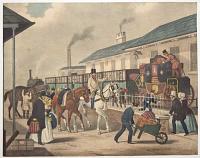
The Last of the Coaches.
[after James Pollard, c.1845]
Lithograph with fine hand-colouring. Sheet 215 x 275mm (8½ x 10¾"). Trimmed to image as normal.
Lithograph after James Pollard's 1845 painting 'The Louth-London Royal Mail Travelling by Train from Peterborough East, Northamptonshire' (New Haven, Yale Center for British Art).
[Ref: 56997] £160.00
(£192.00 incl.VAT)
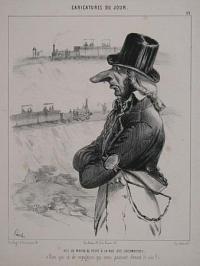
Nez de Maitre de Poste à la Vue des Locomotives. «Rien que çà de voyageurs qui nous passent devant le nez !!»
Imp. d'Aubert & C.ie
Chez Bauger, R. du Croissant, 16. Chez Aubert, Pl. de la Bourse, 29.
Lithograph, 325 x 225mm. 12¾ x 8¾". Light foxing.
Satirical print of a vigilant postmaster, with trains in the background. Not in BM.
[Ref: 8809] £120.00
(£144.00 incl.VAT)

Le Chemin de Fer. Reviens à toi! tendre épouse! . . . Adieu enfans adorés! . . . . recevez tous ma bénédiction ! . . . voilá la vapeur ! . . . . il faut nous séparer !. . . . . jes serai de retour dans vingt minutes , mais hélas ! d'ici lá ! . . . . on ne sait pas ce qui peut arriver !! . . . .
Imp d'Aubert & Co.
Ranger R. du Croissant 16 [n.d., c.1830.]
Lithograph, 250 x 355mm. 9 x 14". Trimmed
A man ordering his wife a children to leave him to embark on a train journey, in the hope that he will return shortly.
[Ref: 8797] £120.00
(£144.00 incl.VAT)

Die Eisenbahn. von London nach Greenwich. CCXXIII.
Aus. d Kunstanst ... Inst. in Hildbh.
Eigenthum d. Verleger. [n.d. c.1850.]
Engraving. 185 x 260mm. 7¼ x 10¼".
Running between London Bridge and Greenwich, the first part of the London & Greenwich Railway opened in 1836, with the entire line completed in 1838. Designed specifically for passenger traffic, it was the first railway in London, and the forerunner of the many inner suburban commuter systems. From Joseph Meyer's "Universum oder abbildung und beschreibung des sehenswerthesten ... der natur und kunst" (Hildburghausen : 1833-1860). In the Science and Society Picture Library.
[Ref: 26019] £75.00
(£90.00 incl.VAT)
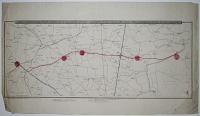
Map of Part of the West Riding of Yorkshire, Shewing the Line of the Proposed Wakefield, Pontefract and Goole Railway. [Annotated in ink with coloured key:]
Bradshaw & Blacklock, Brown Street. Manchester, & Fleet Street, London.
Engraving. Plate 370 x 762mm. 14½ x 30". Some soiling around the edges. Crease lower right corner.
The Wakefield, Pontefract & Goole Railway obtained authorisation in 1845, however it amalgamated prior to construction with the Manchester and Leeds Railway in 1846.
[Ref: 19640] £230.00

Railway Song.
R. Young.
[n.d., c.1840.]
Rare illustrated handbill, broadside, seven letterpress verses with woodcut vignette of steam locomotive pulling two carriages full of passengers. Decorative woodcut border; sheet 190 x 135mm, 7½ x 5¼". Folds and creases, as normal.
Verses in praise of the railway from the early days of steam trains.
[Ref: 19096] £160.00
(£192.00 incl.VAT)

Arabesque Arch.
[Drawn by H. West.]
[E. Colyer Litho. 17, Fenchurch St. n.d., c.1830.]
Lithgraph, 125 x 215mm. 5 x 8½". Laid on separate sheet of paper. Small tear at bottom.
Railway interest. The arabesque arch at Edge Hill, on the Liverpool and Manchester railway.
[Ref: 8862] £85.00
(£102.00 incl.VAT)

Rainhill Bridge, Crossing the Railway at an angle of 34 degrees, Span of the skew face 54 feet._ Width of the Railway underneath 30 feet.
[n.d., c.1830.]
Lithograph, 140 x 170mm. 5½ x 6¾".
The bridge in Rainhill, Merseyside, designed by George Stephenson and constructed from sandstone in 1830. The bridge is known as the 'skew' bridge because it was the first to cross a railway at an angle.
[Ref: 8872] £70.00
(£84.00 incl.VAT)

The Royal Train at Elgin Station, September 6, 1872. [In ink below:] Queen Victoria was on her way to Dunedin.]
Drawn by G. Mackintosh.
Published by James Watson, Bookseller, Elgin. From The "Graphic" of Sept. 21, 1872.
Wood engraving, 202 x 228mm. 8 x 9".
As Scotland’s infrastructure developed – first with road improvements in the early part of the century, then rail (arriving in Elgin in 1852) in the middle years – Elgin became a more attractive spot for the wealthy whether noble or merchant to settle. Villas and fine houses were built by Scots who had made fortunes in the Empire. It even attracted a visit by Queen Victoria in 1872.
[Ref: 22772] £130.00
(£156.00 incl.VAT)

Railway Bridge over the River Tamar.
Drawn by P. Phillips. Engraved by H. Adlard.
[n.d., c.1860.]
Wood engraving. Sheet 230 x 425mm (9 x 16¾") Trimmed into sur-title, tear top right.
An oval view of the Royal Albert Bridge, designed by Isambard Kingdom Brunel (1806-59) to carry the new railway line linking Cornwall to the rest of England. Brunel died shortly after the opening. From the Stationers' Company Almanack.
[Ref: 41335] £220.00
(£264.00 incl.VAT)
![[San Franciso] Hallidie's patent Cable Tramway System, Worked without Horses or Locomotives.](img-thumbnail/jpegs/57099.jpg)
[San Franciso] Hallidie's patent Cable Tramway System, Worked without Horses or Locomotives.
[n.d., c.1883.]
Wood engraving. Sheet 285 x 420mm (11¼ x 16½"). Some creasing. Bit dusty.
A view of the trams on the Clay Street Hill Railroad in San Francisco, the world's first practical cable car system, promoted by Andrew Smith Hallidie (1836-1900). Wellcome: 36611i.
[Ref: 57099] £160.00
(£192.00 incl.VAT)

Viaduct Over the Sankey Valley and Canal Height to the canal 70 feet span of each arch 50 ft.
[n.d., c.1830.]
Lithograph, 145 x 190mm. 5¾ x 7½". Uncut.
The Sankey viaduct, built by George Stephenson between 1828 and 1830 for the Liverpool and Manchester railway. Now a Grade 1 listed building, it is acknowledged as the earliest major railway viaduct in the world. The Sankey canal, which it crosses, was the first canal of the Industrial Revolution, making the site of great significance.
[Ref: 8877] £70.00
(£84.00 incl.VAT)
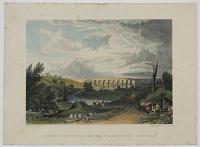
Sankey Viaduct, Liverpool & Manchester Rail-Way.
Drawn by G. Pickering. Engraved by J.H. Kernot.
[n.d., c.1830.]
Coloured engraving. Sheet 145 x 200mm (5¾ x 8") Trimmed within plate.
The Sankey viaduct in Cheshire, built by George Stephenson between 1828 and 1830 for the Liverpool and Manchester railway. Now a Grade 1 listed building, it is acknowledged as the earliest major railway viaduct in the world. The Sankey canal, which it crosses, was the first canal of the Industrial Revolution, making the site of great significance.
[Ref: 35362] £45.00
(£54.00 incl.VAT)
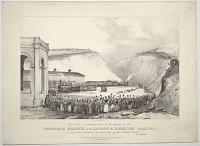
This Print in commemoration of the opening of the Shoreham Branch of the London & Brighton Railway, is repectfully dedicated to the Shareholders by their Obedient Servant, W.H. Mason.
Drawn by H.G Hine. Printed by Lefevre, Newman S.t.
Published by W.H. Mason, at his Respository of Arts, Brighton. [n.d., c.1840].
Very rare lithograph, 275 x 380mm (10¾ x 15"). Small amount of creasing in small margins.
A crowd gathers at Shoreham-by-Sea railway station and along the cliffs waving at two steam trains. The original Shoreham station was a terminus built by the London and Brighton Railway and was opened on 11th May 1840. However it was demolished in 1845 when the Brighton and Chichester Railway opened its line to Worthing railway station. Both railways merged with others in July 1846 to become the London Brighton and South Coast Railway.
[Ref: 57137] £420.00
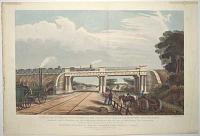
View of the Intersection Bridge on the Line of the St Helens & Rucorn Gap Railway, Crossing the Liverpool and Manchester Railway near the Foot of the Sutton Inclined Plane. Erected by Charles Vignoles, Esq.re C.E., F.R.A.S., Mice. Dedicated by Permission to Edward Greenall, Eq.re of Wilderspool, Cheshire.
S.G. Hughes, Aquat.a.
London, Published 1832, _ by R. Ackermann, No 96 Strand, and J. & J. Mawdsley, Liverpool.
Coloured aquatint with fine hand colour, J. Whatman 1831 watermark. 330 x 470mm (13 x 18½"). Centre fold, creasing.
An extremely fine & rare view of an iron bridge built by Charles Blacker Vignoles (1793-1875) to carry the St Helens and Runcorn Gap Railway over the Liverpool and Manchester Railway, the world's first bridge to carry one railway over another.
[Ref: 59273] £580.00

Bateau à vapeur. Chemin de Fer.
[Schaarbeek, Hemeleers & Van Houter, c.1860.]
Two wood engravings on one sheet. Sheet 280 x 375mm (11 x 14¾"). Creases, nicks to edges.
A naive popular print, illustrating a paddle steamer and steam locomotive.
[Ref: 58587] £120.00
(£144.00 incl.VAT)

Steam Conveyance on a General Iron-Rail-Way. By the Author of Observations on a General Iron-Rail-Way.
Eng. & Prin.d by Palethorpe Nott.m. Published by Baldwin, Cradock & Joy. London.
London, [n.d. after 1825].
Engraving. 395 x 320mm (15½ x 12½"). In mount. Creasing. Repaired tear in right edge going into the plate mark.
Three examples of steam trains with accompanying text extracted from 'Observations on a General Iron-Rail-Way'.
[Ref: 55112] £320.00
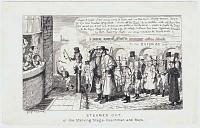
Steamed Out, or the Starving Stage-Coachman and Boys.
George Cruikshank.
[London: David Bogue, 1847.]
Etching. Sheet 105 x 165mm (4¼ x 6½"). Trimmed within plate.
A portly but broken-down coach driver, heading an assortment of thin post boys and others, begs from a well-dressed family at a window. Behind a locomotive crosses a viaduct. Railway interest. From 'The Comic Almanack'.
[Ref: 58728] £95.00
(£114.00 incl.VAT)
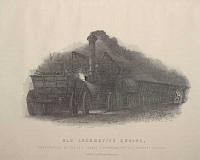
Old Locomotive Engine, constructed by the late George Stephenson, for Killingworth Colliery.
Published by W. Fordyce, Newcastle [n.d., c.1850].
Wood engraving. Printed area 165 x 220mm (6½ x 8¾").
[Ref: 56963] £130.00
(£156.00 incl.VAT)






![[Ljubljana-Trieste Railway] Zur Erinnerung Eröffnung der Staats-Eilenbahn von Laibach bis Triest](img-thumbnail/jpegs/33487.jpg)









![[State Visit of Louis Phillippe of France.] Le Roi a la Station de New-Cross.](img-thumbnail/jpegs/56694.jpg)
![[The Watford Tunnel Collapse, 1835.] A Man that is Married.](img-thumbnail/jpegs/55370.jpg)








![Central Railway Station, Newcastle. (Uniform with a View of the Interior.) [&] Interior of the Central Railway Station, Newcastle. (Uniform with a View of the Exterior.)](img-thumbnail/jpegs/27411.jpg)














![[San Franciso] Hallidie's patent Cable Tramway System, Worked without Horses or Locomotives.](img-thumbnail/jpegs/57099.jpg)







